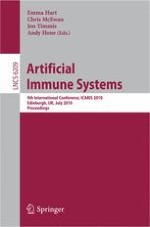Arti?cial immune systems (AIS) is a diverse and maturing area of research that bridges the disciplines of immunology and computation. The original research impetus in AIS had a clear focus on applying immunological principles to c- putationalproblemsinpracticaldomainssuchascomputersecurity,datamining and optimization. As the ?eld has matured, it has diversi?ed such that we now see a growing interest in formalizing the theoretical properties of earlier - proaches, elaborating underlying relationships between applied computational models and those from theoretical immunology, as well a return to the roots of the domain in which the methods of computer science are being applied to - munological modelling problems. Following the trends in the ?eld, the ICARIS conference intends to provide a forum for all these perspectives. The 9th InternationalConference on AIS (ICARIS 2010)built on the success of previous years, providing a convenient vantage point for broader re?ection as it returned to Edinburgh, the venue of the Second ICARIS in 2003. This time, the conference was hosted by Edinburgh Napier University at its Craiglockhart Campus, recently reopened after extensive refurbishment which has resulted in a stunning building and state-of-the-art facilities. The extent to which the ?eld has matured over the preceding years is clear; a substantial track of theor- ical research now underpins the discipline. The applied stream has expanded in its outlook, and has examples of AIS algorithms being applied across a wide spectrum of practicalproblems,rangingfrom sensornetworksto semi-conductor design.
